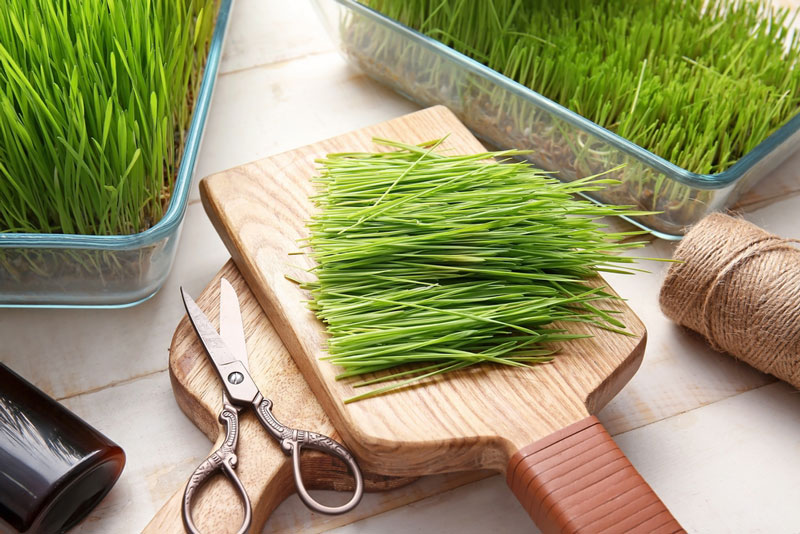Have you ever wondered if cats can eat wheat grass? Well, the answer is yes, they can! Wheat grass is not only safe for our furry friends but can also be beneficial for them. Cats are naturally curious creatures and enjoy nibbling on a variety of greens, and wheat grass is one of the safest options to consider.
This delightful green treat is packed with nutrients and can help cats with digestion as well. Plus, let’s be honest; watching your cat munch on a bit of grass is both entertaining and adorable, isn’t it? So now that we’ve got a resounding yes to our question, why don’t we explore what makes wheat grass so appealing and what we should keep in mind when offering it to our cats?
Stick around as we explore the ins and outs of wheat grass for cats in this article. We’re going to cover everything from the benefits to potential risks and even some alternatives. Let’s make sure we’re well-informed about this green delight for our feline companions!
You might also be interested in: Can Cats Eat Broccoli?
Can Cats Eat Wheat Grass?

Wheat grass is the young shoots of the wheat plant, specifically the Triticum aestivum species. It’s rich in vitamins and minerals, so it is not surprising that many pet owners are curious about its suitability for their cats. The great news is that wheat grass is safe for cats to consume in small amounts.
Wheat grass provides cats with essential nutrients, including vitamins A, C, and E as well as amino acids and chlorophyll. As obligate carnivores, cats require a diet rich in protein. However, incorporating a bit of wheat grass into their diet provides additional micronutrients and may also help with digestion. Many cats will instinctively seek out greens like wheat grass, and they may do so to help induce vomiting. While this may sound concerning, it’s a natural behavior that helps them get rid of furballs or indigestible items.
It’s important, though, to be aware that not all types of grass are safe for our feline friends. Some grasses might be treated with pesticides or herbicides that can be harmful. Therefore, when introducing wheat grass, ensure that it is organic and free from chemicals. You can often find wheat grass at pet stores or even grow your own at home. What a fun way to green up the house while giving our pets a tasty treat!
How Much Wheat Grass Can Cats Eat?
We should consider how much wheat grass we let our cats munch on. Generally, moderation is key! A few small bites here and there should be enough for them to enjoy. It’s similar to how we sometimes enjoy a tasty snack; it should complement our main meal, and not replace it.
Introducing wheat grass to your cat can be done gradually. Start with a small amount, perhaps allowing them to nibble on a couple of leaves. Observe how they react; if everything seems normal, you can offer a bit more. Every cat is unique, and preferences vary widely, so pay attention to what your feline friend seems to enjoy.
It’s also essential to keep an eye on their digestion. If they show any signs of distress or if they seem to have trouble after eating wheat grass, it might be best to reduce the amount or even discontinue giving it altogether. Always consult with your vet if you’re unsure. They can help provide guidance on appropriate amounts based on your cat’s health, age, and dietary needs.
Remember, while wheat grass can be a healthy and fun addition to our cats’ lives, their main diet should still focus on high-quality cat food designed for their nutritional needs. This yummy green can enhance their diet, but it should not become the primary focus of their meals.
Benefits Of Wheat Grass To Cats
1. Digestive Aid: One of the most significant benefits of wheat grass for cats is its potential to aid digestion. Just like we sometimes reach for fiber to help our tummy, wheat grass can help our feline friends, too. It contains natural enzymes that can support digestive health, and many cats will nibble on it when they feel the need to purge hairballs or other indigestible items.
2. Nutritional Value: Wheat grass is a powerhouse of nutrients. It contains vitamins A, C, and E, as well as various B vitamins. These vitamins are crucial for maintaining a shiny coat, supporting their immune system, and providing overall health. They can help keep our cats feeling their best, which benefits all of us!
3. Antioxidant Properties: Antioxidants are essential for fighting off free radicals in our bodies, and wheat grass is rich in these beneficial compounds. By incorporating wheat grass into their diet, we can potentially help our cats combat oxidative stress, which may reduce the risk of some diseases and promote longevity.
4. Fresh Breath: Believe it or not, wheat grass can also help freshen our cats’ breath! Chewing on it may help remove tartar and dental plaque, contributing to better overall oral hygiene. When our kitties’ breath smells good, it’s a win-win for cuddles and snuggles!
5. Enrichment and Entertainment: Having fresh wheat grass available gives our cats a fun activity that simulates their natural behavior. Catnip is great, but there’s something special about watching our feline pals enjoy some greens. It can also be a great way to express their hunting instincts without us having to go out and catch some mice!
Dangers Of Feeding Wheat Grass To Cats
While wheat grass can offer some great benefits, we should also be aware of the risks associated with it. It’s important to approach any new addition to our pets’ diets with caution. Here are some of the potential dangers.
One concern includes possible gastrointestinal upset if a cat consumes too much wheat grass. Too much of a good thing can be bad, and if cats overindulge, it could lead to symptoms such as vomiting or diarrhea. Therefore, always aim for moderation.
Another risk involves chemical exposure. If the wheat grass is grown outdoors, it may be treated with pesticides that could be harmful. It’s always best to source organic wheat grass to ensure that our cats are safe. Additionally, even indoor plants can sometimes absorb chemicals from their surroundings, so it’s wise to look for reputable suppliers.
Some cats may also have allergies or sensitivities. Always observe your cat after introducing any new food to their diet. If you notice any unusual behavior or health issues, it’s best to reach out to a veterinarian for advice.
Lastly, although wheat grass can help with digestion, it is not a substitute for a balanced diet. Cats need a protein-rich diet catered to their carnivorous needs. When we focus primarily on health treats like wheat grass and lessen the necessary nutrients from their diet, it may lead to nutritional imbalance.
Substitute Of Wheat Grass For Cats
1. Cat Grass: Cat grass is a blend of assorted edible grasses such as oat, barley, and rye. These are excellent alternatives to wheat grass and safe for cats to munch on. They offer similar digestible benefits and can help with hairballs and general digestive health.
2. Catnip: Catnip is probably one of the most loved herbs for our felines. While it provides a different set of benefits from wheat grass, it can still offer stimulation and enrichment. Plus, it’s known to give many cats feelings of euphoria!
3. Fresh Herbs: We can also consider offering safe herbs like parsley or mint, which can be enjoyable for kitties. Always ensure that any herbs are organic and free of pesticides.
4. Parsley: This is a safe herb, loaded with nutrients and vitamins for our furry companions. Just be cautious about how much you give them, as excessive amounts may lead to other issues.
5. Sprouts: We can try offering our cats safe sprouts like alfalfa and lentil sprouts. These are nutritious and fun for cats to munch on and can serve as a great snack alternative to wheat grass.
Can Cats Eat Wheat Grass? Frequently Asked Questions
Can All Cats Eat Wheat Grass?
Yes, most cats can eat wheat grass safely. However, it is always good to introduce it gradually and watch for any adverse reactions.
How Do I Grow Wheat Grass For My Cat?
Growing wheat grass at home is easy! You can find wheat grass seeds online or at local gardening stores. Soak the seeds overnight, plant them in a pot with soil, and keep them in a sunny spot. Water it regularly, and soon your kitty will have their own fresh treats to enjoy!
Can Wheat Grass Help My Cat’s Fur?
Yes! The vitamins and nutrients found in wheat grass can help promote healthy fur and skin, leading to a shinier coat.
How Often Can I Give My Cat Wheat Grass?
Offering small amounts of wheat grass a few times a week is generally fine. However, observe how your cat reacts, and adjust accordingly.
What Should I Do If My Cat Refuses To Eat Wheat Grass?
If your cat isn’t interested in wheat grass, that’s okay! Cats have individual tastes just like we do. You could try other safe greens and herbs, or consult your vet for other suggestions!
Final Thoughts
In conclusion, wheat grass can be a fantastic addition to our cats’ lives! It’s loaded with nutrients that help keep our feline friends happy and healthy. With moderation, care, and a little bit of research, we can incorporate this delightful treat into their diet safely. However, paying attention to our cats and being mindful of their responses is crucial, just like it would be for our own health.
We hope you learned something new today! If you’re curious about keeping your pets healthy and happy, take a moment to explore other fascinating topics, like if cats can eat chocolate or what treats are safe for dogs. Let’s keep our furry buddies thriving!
For more, check out our blog for great tips, and be sure to read about cats and sunflowers and see if cats can eat corn!


